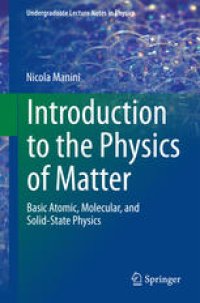
Ebook: Introduction to the Physics of Matter: Basic atomic, molecular, and solid-state physics
Author: Nicola Manini (auth.)
- Genre: Physics // General courses
- Tags: Atomic/Molecular Structure and Spectra, Condensed Matter Physics, Statistical Physics Dynamical Systems and Complexity, Quantum Physics, Thermodynamics
- Series: Undergraduate Lecture Notes in Physics
- Year: 2014
- Publisher: Springer International Publishing
- Edition: 1
- Language: English
- pdf
This book offers an up-to-date, compact presentation of basic topics in the physics of matter, from atoms to molecules to solids, including elements of statistical mechanics. The adiabatic separation of the motion of electrons and nuclei in matter and its spectroscopic implications are outlined for molecules and recalled regularly in the study of the dynamics of gases and solids. Numerous experiments are described and more than 160 figures give a clear visual impression of the main concepts. Sufficient detail of mathematical derivations is provided to enable students to follow easily. The focus is on present-day understanding and especially on phenomena fitting various independent-particle models. The historical development of this understanding, and phenomena such as magnetism and superconductivity, where interparticle interactions and nonadiabatic effects play a crucial role, are mostly omitted. A final outlook section stimulates the curiosity of the reader to pursue the study of such advanced topics in graduate courses.
This book offers an up-to-date, compact presentation of basic topics in the physics of matter, from atoms to molecules to solids, including elements of statistical mechanics. The adiabatic separation of the motion of electrons and nuclei in matter and its spectroscopic implications are outlined for molecules and recalled regularly in the study of the dynamics of gases and solids. Numerous experiments are described and more than 160 figures give a clear visual impression of the main concepts. Sufficient detail of mathematical derivations is provided to enable students to follow easily. The focus is on present-day understanding and especially on phenomena fitting various independent-particle models. The historical development of this understanding, and phenomena such as magnetism and superconductivity, where interparticle interactions and nonadiabatic effects play a crucial role, are mostly omitted. A final outlook section stimulates the curiosity of the reader to pursue the study of such advanced topics in graduate courses.